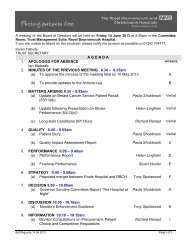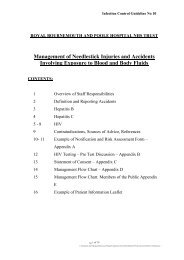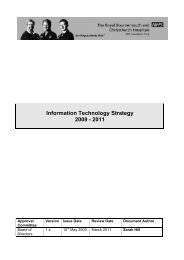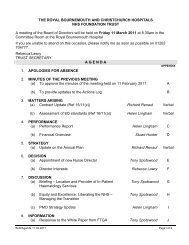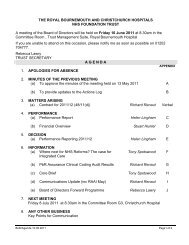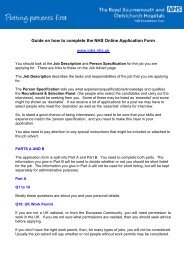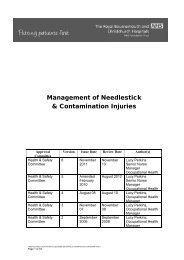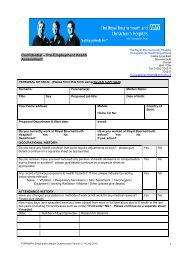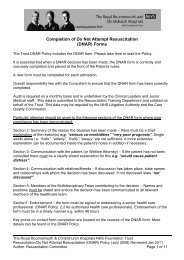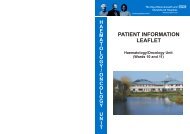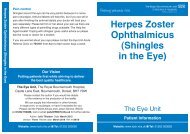Annual Report and Accounts 2012/13 - Royal Bournemouth Hospital
Annual Report and Accounts 2012/13 - Royal Bournemouth Hospital
Annual Report and Accounts 2012/13 - Royal Bournemouth Hospital
- No tags were found...
Create successful ePaper yourself
Turn your PDF publications into a flip-book with our unique Google optimized e-Paper software.
Financial <strong>Accounts</strong><strong>Annual</strong> Governance StatementScope of responsibilityAs Accounting Officer, I haveresponsibility for maintaining a soundsystem of internal control that supportsthe achievement of the NHS FoundationTrust’s policies, aims <strong>and</strong> objectives,whilst safeguarding the public funds<strong>and</strong> departmental assets for which I ampersonally responsible, in accordancewith the responsibilities assigned to me.I am also responsible for ensuring thatthe NHS Foundation Trust is administeredprudently <strong>and</strong> economically <strong>and</strong> thatresources are applied efficiently <strong>and</strong>effectively. I also acknowledge myresponsibilities as set out in the NHSFoundation Trust Accounting OfficerMemor<strong>and</strong>um.The purpose of the system ofinternal controlThe system of internal control is designedto manage risk to a reasonable levelrather than to eliminate all risk of failure toachieve policies, aims <strong>and</strong> objectives; itcan therefore only provide reasonable <strong>and</strong>not absolute assurance of effectiveness.The system of internal control is basedon an ongoing process designed toidentify <strong>and</strong> prioritise the risks to theachievement of the policies, aims <strong>and</strong>objectives of The <strong>Royal</strong> <strong>Bournemouth</strong> <strong>and</strong>Christchurch <strong>Hospital</strong>s NHS FoundationTrust, to evaluate the likelihood of thoserisks being realised <strong>and</strong> the impact shouldthey be realised, <strong>and</strong> to manage themefficiently, effectively <strong>and</strong> economically.The system of internal control has beenin place in The <strong>Royal</strong> <strong>Bournemouth</strong> <strong>and</strong>Christchurch <strong>Hospital</strong>s NHS FoundationTrust for the year ended 31 March 20<strong>13</strong><strong>and</strong> up to the date of approval of theannual report <strong>and</strong> accounts.Capacity to h<strong>and</strong>le riskAs Accounting Officer I have ultimateresponsibility for ensuring that there isan effective risk management system inplace within the Foundation Trust <strong>and</strong> formeeting all statutory responsibilities <strong>and</strong>adhering to guidance issued by Monitorin respect of governance. The executivewith specific responsibility for risk isthe Director of Nursing <strong>and</strong> Midwifery.However, the requirement to managerisk more effectively is a responsibilityaffecting all staff in every part of theFoundation Trust, from the controlof finance, through all the disciplinessupporting <strong>and</strong> delivering the environmentof care, to the direct delivery of clinicalcare itself, risk management is everyone’sresponsibility. The Foundation Trust’sRisk Management Strategy clearly definesthese responsibilities <strong>and</strong> providesguidance for the fulfilment of these roles.The Trust has an accredited IOSH riskmanagement training course in place<strong>and</strong> it is m<strong>and</strong>atory for all managers <strong>and</strong>staff in a managerial role to attend. TheBoard of Directors has undertaken IOSHDirecting Safely training. The trainingprovides staff with the skills requiredto recognise, manage <strong>and</strong> monitor riskwithin their areas of responsibility. Riskmanagement <strong>and</strong> health <strong>and</strong> safetytraining is also including on induction<strong>and</strong> m<strong>and</strong>atory training programmesfor all staff. Formal training is thensupported by a variety of other resourcesthat seek to promote <strong>and</strong> facilitateindividual, departmental, directorate<strong>and</strong> organisational learning. As anexample, the Clinical Governance & RiskCommittee produce a quarterly ClinicalGovernance report which highlightspatient safety, patient experience <strong>and</strong>patient outcome trends for the period.The report includes the results ofcomplaints, claims <strong>and</strong> adverse incidentinvestigations <strong>and</strong> notes examplesof, <strong>and</strong> recommendations for, qualityimprovement <strong>and</strong> safe practice. Theserecommendations are fed throughfor discussion at directorate clinicalgovernance groups, senior nurses <strong>and</strong>clinical leader meetings.6<strong>Annual</strong> <strong>Report</strong> <strong>and</strong> <strong>Accounts</strong> <strong>2012</strong>/<strong>13</strong>



